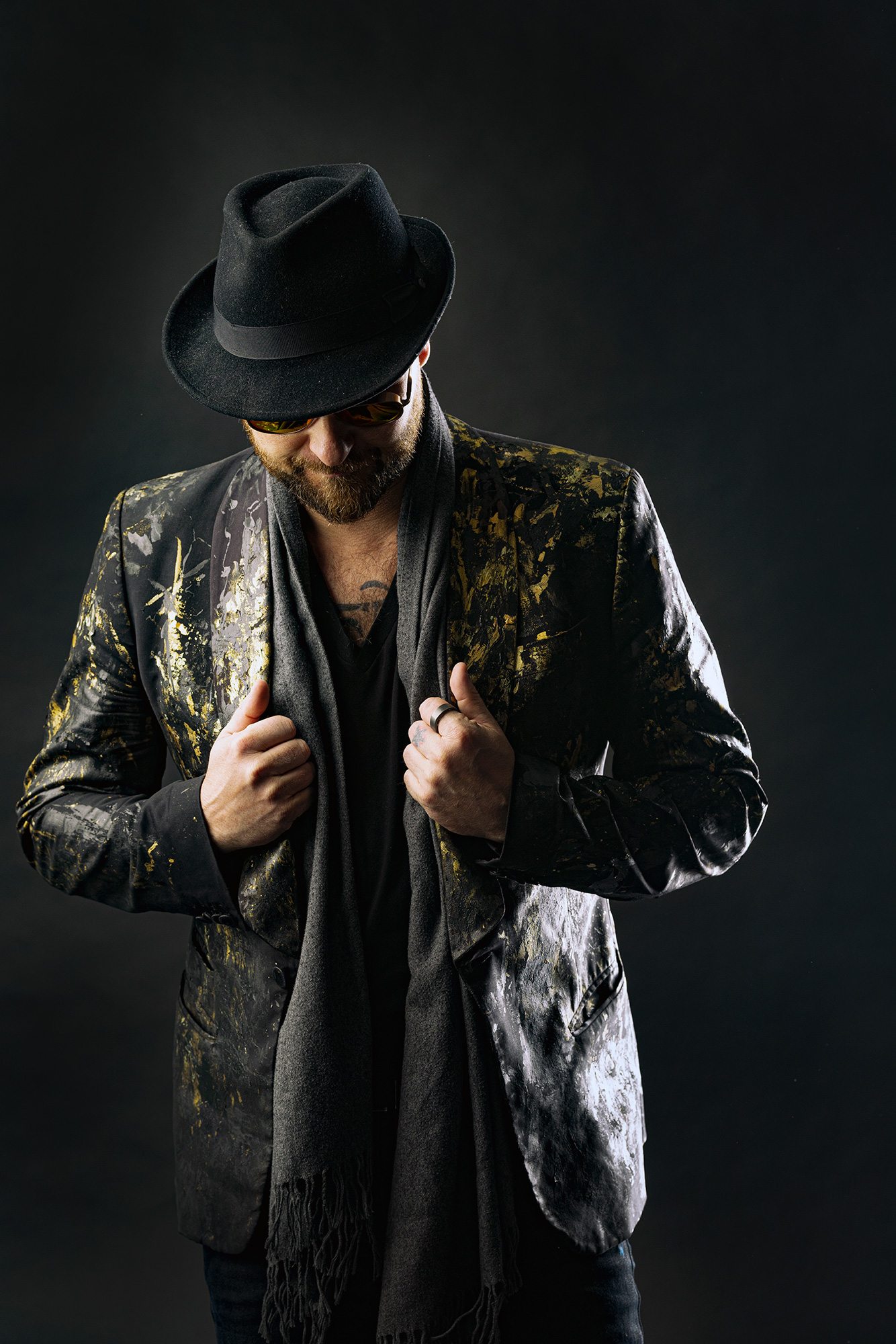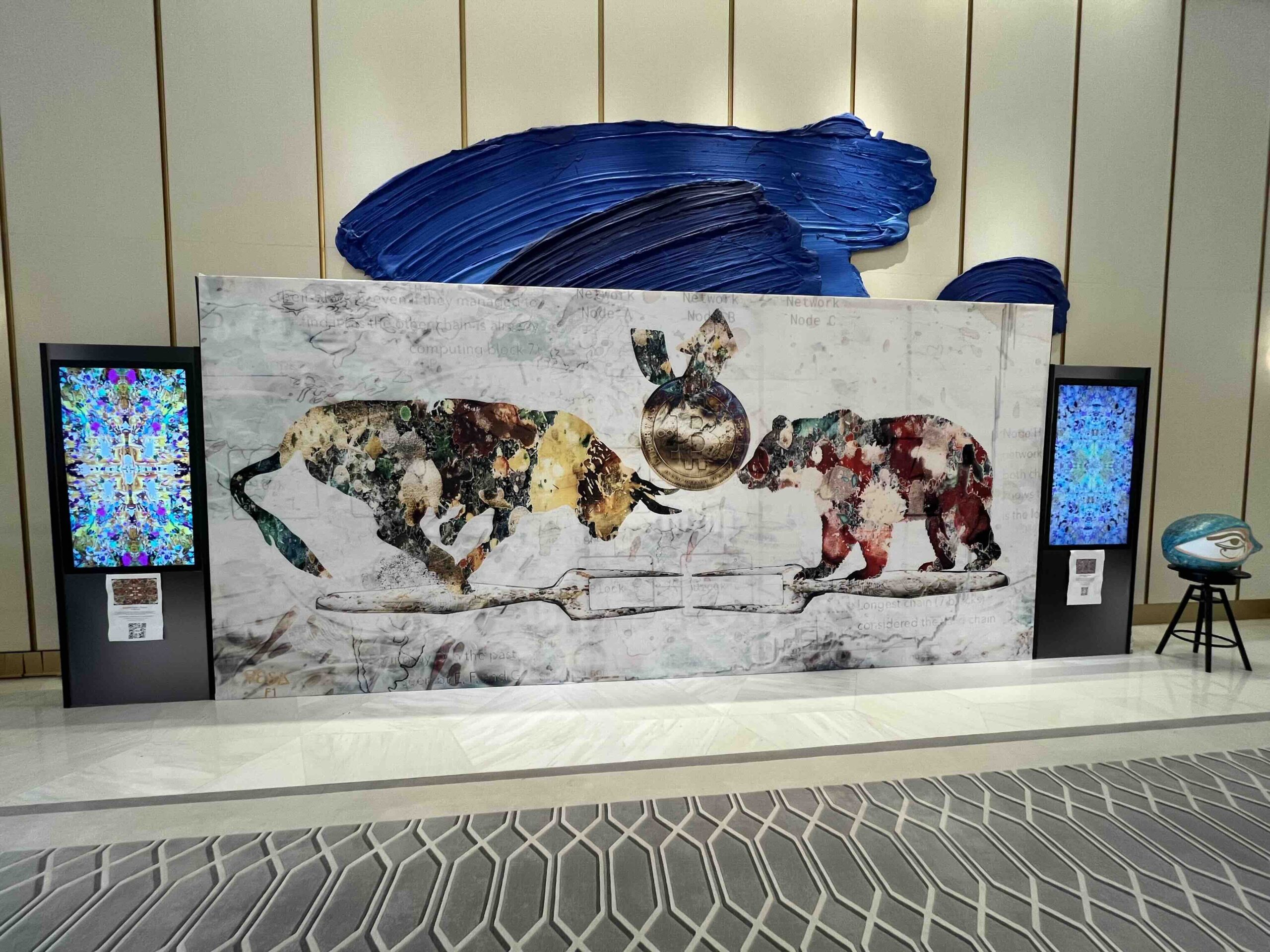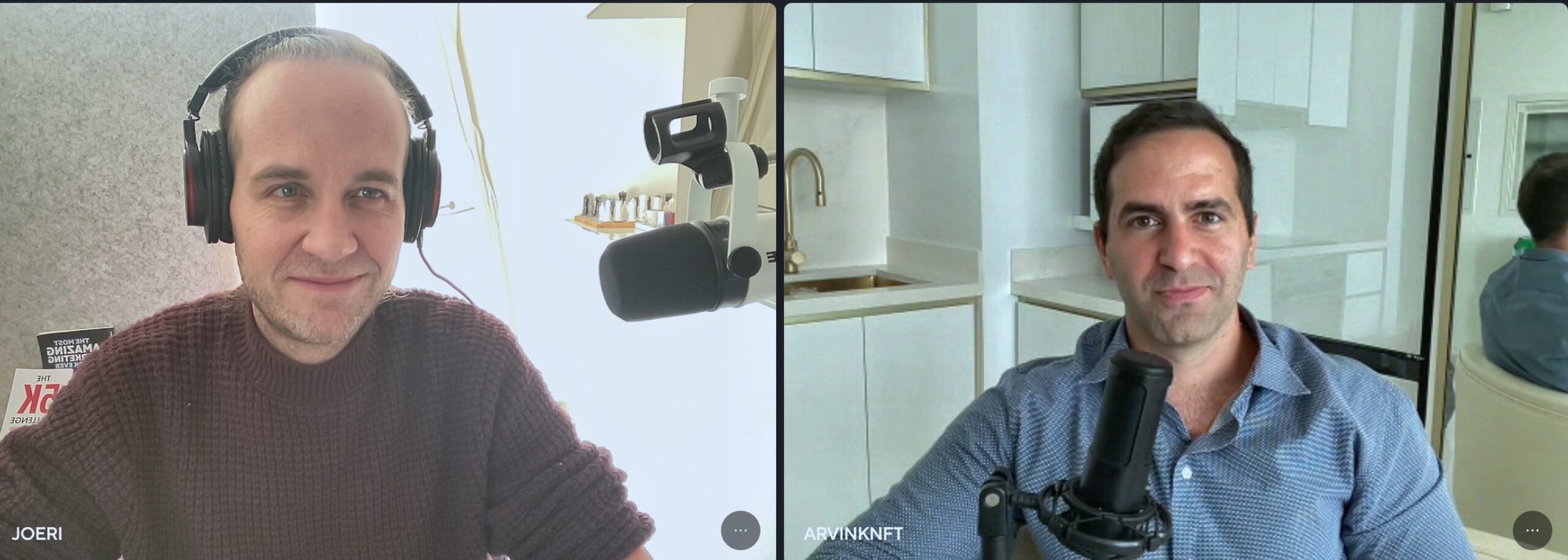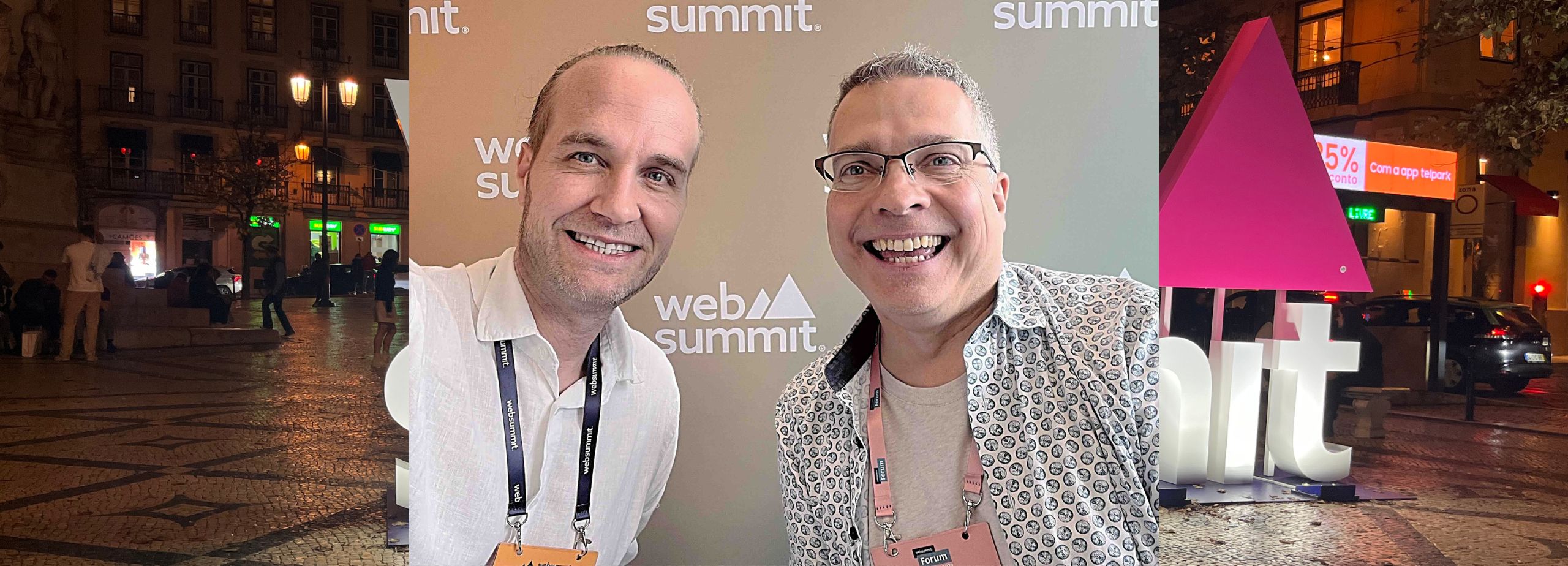VESA is a multi-award winning digital art pioneer with 15 years of experience. He is among the first five artists to start making crypto art & NFTs in 2017. He is considered to be a leading artist building the Web3 fine art realm, winning the NFT Artist of the Year from AIBC Summit (2023) top Web3 Artists award from L’Officiel Arabia and World NFT artist Award in Korea (both 2022). His last museum show was at the Museum of the Future in Dubai.
In 2013, his digital art project with actress Veena Malik reached around 300M people, with critical acclaim. He is also the founder of VESA Digital LLC, a company in Dubai focusing on holistic physical & digital art experiences. VESA is currently working with “The Great Hack” Netflix documentary star Brittany Kaiser for a web3 art project, and a commission piece for Crypto(dot)com.
His art has been collected by hedge funds, exchanges, CEO's and influencers. Among them are Charles Hoskinson, Charlie Lee, Dr Marwan Al Zarouni, H.E Amna Fikri, Mondoir, Saeed Al Darmaki, Colborn, Tone Vays, Coach K, Willy Woo, and many others.
Art Meets the Digital Frontier: A New Era of Creativity
Imagine stepping into a painting, walking through a digital gallery from your living room, or owning a unique piece of art that exists only in the digital world. Welcome to the intersection of art and technology.
In this exploration, we'll uncover how technology has not only transformed the tools artists use but has also expanded the very definition of art. From the digital canvases of the internet to the immersive realms of virtual reality, technology has opened up new horizons for creativity, expression, and interaction. We'll see how blockchain and the metaverse are redefining ownership and accessibility, making art a more inclusive and global conversation.
The impact of this evolution is profound, challenging our perceptions of art, its value, and how we connect with it. It's a revolution that's making art more accessible and engaging for everyone, everywhere.
Curious about how this all works and what it means for the future of art? Let's deep-dive into the digital age of art, exploring its opportunities, challenges, and the boundless possibilities it presents.
The Evolution of Art and Technology
The Technological Evolution in the Art World
Art and technology have always been intertwined, but the last few decades have seen an unprecedented acceleration in this relationship. The art world, traditionally seen as a custodian of physical and tangible creations, is now at the cusp of a digital renaissance. This transformation is not just about the digitization of existing artworks but involves the birth of entirely new forms of art made possible by technological advancements. The digital age has ushered in tools and platforms that allow for the creation, distribution, and consumption of art in ways that were unimaginable just a few years ago. However, it's important to note that many within the art community, including artists themselves, are still grappling with the full implications of these changes. The opportunities now available are vast, yet fully understanding and leveraging them remains a work in progress.
The Opportunities for Artists in the Digital Age
For artists, the digital age opens up a world of possibilities that extend far beyond the traditional gallery system. Digital platforms offer new avenues for exposure and monetization, breaking down geographical and financial barriers that once limited an artist's reach. The rise of social media, for example, allows artists to connect directly with their audience, bypassing traditional gatekeepers and fostering a more personal relationship with their followers. Furthermore, digital art forms such as virtual reality, augmented reality, and interactive installations offer new mediums for creative expression, enabling artists to engage their audience in immersive and innovative ways. These technological advancements not only expand the toolkit available to artists but also challenge them to rethink the very nature of what art can be.
The Transition from Traditional to Digital Art
The transition from traditional to digital art marks a significant shift in the artistic process and the perception of art itself. Artists who embrace digital tools find themselves navigating a new creative frontier, one where the lines between the physical and virtual, the real and the imagined, are increasingly blurred. This shift is not without its challenges, as artists must learn to harness the potential of digital tools without losing the essence of their creative vision. The process of creating digital art often involves a blend of technical skill and artistic intuition, requiring artists to be both creators and innovators. As digital art continues to evolve, it challenges traditional notions of artistry, pushing the boundaries of what is possible and opening up new realms of creative exploration.
The Impact of Technology on the Perception of Art
The impact of technology on the perception of art is profound and far-reaching. As digital art becomes more prevalent, questions arise about the value, authenticity, and ownership of digital creations. Unlike physical artworks, digital pieces can be easily copied, shared, and modified, leading to debates about what constitutes an original work of art in the digital age. Furthermore, the immersive and interactive nature of many digital artworks challenges traditional passive modes of art consumption, inviting viewers to become active participants in the artistic experience. This shift not only changes how art is experienced but also how it is valued, both aesthetically and economically. As the art world continues to grapple with these changes, it becomes clear that technology is not just transforming the tools of art creation but is reshaping the very foundations of how we understand and appreciate art.

VESA Kivinen on the Web3 CMO Stories podcast
The Intersection of Art and Blockchain
The introduction to crypto art and NFTs marks a pivotal moment in the ongoing fusion of art and technology. Crypto art, powered by blockchain technology, has introduced the concept of Non-Fungible Tokens (NFTs) to the world. NFTs are unique digital assets that represent ownership or proof of authenticity of a digital work of art. This innovation has opened up new frontiers for artists and collectors alike, allowing for the creation, sale, and collection of digital art in a manner that was previously impossible. The uniqueness of each NFT, guaranteed by blockchain technology, ensures that digital artworks can now be "owned" in a similar way to physical art, despite their inherently reproducible nature. This has led to a reevaluation of what art is in the digital age, expanding the market and creating new forms of value around digital creations.
The role of blockchain in authenticating digital originals is perhaps one of the most significant contributions of this technology to the art world. Before the advent of blockchain, digital art suffered from a perception issue; without a way to verify authenticity or ownership, digital works were often seen as less valuable than their physical counterparts. Blockchain technology has changed this narrative by providing a decentralized and immutable ledger that can prove the provenience and originality of digital artworks. This authentication process not only elevates the status of digital art but also empowers artists to have more control over their work. By minting their creations as NFTs, artists can ensure that their digital pieces are recognized as original works of art, thereby enhancing their value and collectibility.
The influence of blockchain on the monetary system extends beyond the art world, challenging and innovating the traditional financial systems in place. Blockchain's decentralized nature offers an alternative to the centralized banking system, introducing concepts such as cryptocurrencies and smart contracts. This has implications not only for artists but for society as a whole, as it presents a new way of thinking about value, ownership, and the exchange of goods. For artists, particularly those working with digital and crypto art, this means access to a global market without the need for traditional financial intermediaries. It also means that artists can create more direct economic relationships with their audience, offering potential for greater financial autonomy and creative freedom.
The opportunities and challenges of being an early adopter in the NFT art space are manifold. Early adopters of NFTs and crypto art have navigated a rapidly evolving terrain, filled with both unprecedented opportunities and significant challenges. On one hand, artists entering the space early have had the chance to define its contours, setting precedents for how digital art is created, sold, and valued. They've been able to reach global audiences, secure significant sales, and participate in the creation of a new art market. On the other hand, these pioneers have also faced skepticism, technical hurdles, and the volatility of the crypto market. The early days of NFT art were marked by a lack of understanding and acceptance, both from the traditional art world and the broader public. Moreover, the technical complexity of blockchain and NFTs posed barriers to entry for many artists and collectors. Despite these challenges, the early adopters of NFT art have played a critical role in shaping a new paradigm for art in the digital age, demonstrating the potential for blockchain technology to transform not just the art market, but the very nature of how art is created, shared, and valued.
The Impact of Web3 on the Art World
The transformation of the art world through Web3 is nothing short of revolutionary. Web3, with its decentralized nature, has not only democratized the creation and distribution of art but also redefined the value and ownership of digital assets. This transformation is evident in how artists now have unprecedented access to a global audience, bypassing traditional gatekeepers such as galleries and auction houses. The decentralization aspect of Web3 means that artists can directly connect with their audience, fostering a more intimate and immediate relationship. This direct connection not only empowers artists but also encourages a more engaged and invested community of art enthusiasts and collectors. Furthermore, the global reach of Web3 platforms breaks down geographical barriers, allowing artists from any part of the world to showcase their work on an international stage. This global exposure is particularly beneficial for artists from regions previously underserved by the traditional art market, offering them visibility and opportunities that were once out of reach.
The benefits of blockchain for artists are manifold and extend beyond the simple authentication of digital originals. Blockchain technology offers artists control over their work, from creation to sale, and even in secondary markets. Through smart contracts, artists can automate royalties, ensuring they receive a percentage of sales whenever their art is resold. This is a significant departure from the traditional art market, where artists typically benefit only from the initial sale. Moreover, blockchain's transparency provides a clear provenience trail, enhancing trust and confidence among buyers and collectors. This level of transparency and control is unprecedented in the art world and represents a major shift in how artists manage their careers and monetize their work. Additionally, the ability to tokenize physical artworks as NFTs opens up new possibilities for artists to experiment with hybrid forms of art, blending the digital and physical in innovative ways.
The shift in perception of NFTs from speculation to art and ownership marks a significant evolution in the understanding and appreciation of digital art. Initially, the frenzy around NFTs was largely driven by speculation, with headlines focusing on record-breaking sales and the speculative nature of the crypto market. However, as the dust settles, a deeper appreciation for the artistic and cultural value of NFTs is emerging. This shift is characterized by a growing recognition of NFTs as a legitimate form of art, with intrinsic value beyond their speculative potential. Collectors and enthusiasts are beginning to appreciate the craftsmanship, creativity, and innovation that goes into creating digital art, recognizing NFTs as a new medium for artistic expression. This evolution in perception is encouraging a more sustainable and mature market for digital art, where the focus is on the art itself and the unique opportunities that blockchain technology offers for artists and collectors alike.
The potential of Web3 for creativity and innovation in the art world is boundless. Web3 technologies not only provide new tools and platforms for artists to express themselves but also challenge them to rethink the very nature of art and its role in society. The intersection of art, technology, and finance that Web3 represents opens up new avenues for experimentation, collaboration, and innovation. Artists are exploring the use of virtual reality, augmented reality, and other digital mediums to create immersive and interactive art experiences that were previously unimaginable. Moreover, the participatory nature of Web3 allows for collaborative art projects that engage communities in the creative process, blurring the lines between artist and audience. This environment of experimentation and collaboration, fueled by the technological capabilities of Web3, is fostering a new era of creativity that is pushing the boundaries of what art can be and do. As we continue to witness the unfolding impact of Web3 on the art world, it is clear that we are only at the beginning of a profound transformation that will redefine art for the digital age.
The Creative Process in Digital Art
Conceptualizing digital art pieces begins with an idea, a spark that ignites the creative process. This initial concept can come from anywhere - a personal experience, a reaction to societal issues, or even an exploration of abstract concepts. The digital artist, equipped with a palette of software and hardware, starts by sketching out this idea, experimenting with colors, forms, and compositions. Unlike traditional art forms, where the medium imposes certain limitations, digital art offers an expansive field of possibilities. Artists can manipulate their pieces in ways that would be impossible on canvas or sculpture, such as easily altering colors, incorporating motion, or adding interactive elements. This freedom allows for a level of experimentation and iteration that is unique to digital creation, enabling artists to refine their vision with precision until it aligns with their initial concept.
The influence of digital nature on the creative process is profound. The very essence of digital art lies in its capacity for transformation and evolution. The digital medium is fluid, allowing artists to continuously modify their work, sometimes even after it has been shared with the public. This dynamic nature encourages a process of ongoing creation and recreation, which can lead to unexpected discoveries and innovations. Moreover, the digital environment introduces artists to new tools and technologies, such as artificial intelligence and virtual reality, pushing them to learn and adapt. This constant evolution of digital tools and platforms not only influences the techniques used by artists but also expands the scope of what art can be. It challenges artists to think beyond traditional boundaries and to consider how their work interacts with technology and its audience in a digital space.
The challenges and opportunities of digital artistry are two sides of the same coin. On one hand, the digital world offers unparalleled opportunities for artists to reach a global audience, collaborate with peers across continents, and engage with their followers in real-time. On the other hand, the digital space is saturated with content, making it challenging for artists to stand out and capture the attention of viewers. Additionally, the ephemeral nature of digital art raises questions about permanence and value, pushing artists to find innovative ways to ensure their work is preserved and appreciated. However, these challenges also drive creativity and innovation. They compel artists to be more strategic in how they market their work, to leverage social media and other digital platforms effectively, and to continually push the boundaries of their creative expression.
The role of collaboration in the creation of digital art is increasingly significant. The interconnectedness of the digital world facilitates collaborations that would have been logistically impossible in the past. Artists can now work together from different parts of the globe, combining their skills and perspectives to create something truly unique. This collaborative process is not limited to artists alone but can also include technologists, scientists, and thinkers, leading to interdisciplinary projects that blur the lines between art, technology, and science. Such collaborations can result in innovative works that challenge our perceptions and engage audiences in new and meaningful ways. Furthermore, the participatory nature of many digital platforms allows the audience to become part of the creative process, offering feedback, contributing ideas, or even altering the artwork itself. This dynamic interaction between the artist, the work, and the audience is a distinctive feature of digital art, enriching the creative process and deepening the impact of the art.
The Role of Spirituality in Art
The influence of spirituality on the creation of art is both profound and multifaceted. Spirituality, with its deep roots in human consciousness, has always been a fertile ground for artistic exploration. Artists like Andrew Jones, who draw heavily on spiritual themes, showcase how spirituality can serve as a powerful muse, inspiring creators to venture beyond the tangible and into realms of the abstract and metaphysical. These artists often tap into ancient traditions and wisdom, channeling them into their work to create pieces that are not only visually stunning but also rich in symbolic meaning. This spiritual dimension adds layers of depth to art, inviting viewers to engage with it on a more introspective level. In the digital age, where the creation of art can seem detached due to the medium's technical nature, integrating spirituality can imbue the work with a sense of soulfulness and connection, bridging the gap between the artist's vision and the audience's experience.
The shift in societal acceptance of spirituality in art reflects broader cultural changes. For a long time, the art world, particularly in its more institutional forms, has maintained a secular stance, often sidelining or even mocking spiritual themes. This skepticism was partly due to a broader societal shift towards secularism and a preference for art that engages with material or political realities. However, as society becomes more open to diverse perspectives and as the boundaries between different belief systems blur, there's a growing acceptance of spirituality in art. This shift is notably visible in the digital and NFT spaces, where there's a burgeoning interest in artworks that tackle spiritual themes. These platforms offer a new frontier for artists to express their spiritual visions without the constraints of traditional art institutions, signaling a significant transformation in how spirituality is perceived and valued in the art world.
The impact of spirituality on the interpretation of art is substantial. When art incorporates spiritual elements, it invites viewers to engage with it on a level that transcends aesthetic appreciation. Such artworks often provoke contemplation, encouraging individuals to reflect on their own beliefs, values, and the mysteries of existence. This interaction can be profoundly personal, as it touches on the viewer's innermost thoughts and feelings. Moreover, spiritual art has the unique ability to connect people across different cultures and backgrounds, as it deals with universal themes that resonate with the human condition. In the context of digital art, where the audience is global, this capacity to transcend cultural barriers and speak to shared human experiences is especially poignant. It demonstrates how spirituality can serve as a universal language in art, fostering a sense of unity and understanding among disparate communities.
The integration of spiritual themes in digital art represents an exciting convergence of ancient wisdom and modern technology. Digital artists who incorporate spiritual themes into their work are not only continuing a long tradition of exploring the metaphysical through art but are also redefining how these themes are expressed and experienced. By leveraging digital tools and platforms, artists can create immersive, interactive pieces that offer viewers new ways to engage with spiritual concepts. For instance, virtual reality can transport users into symbolic landscapes inspired by spiritual narratives, while augmented reality can overlay sacred geometries onto our everyday environment. These technological innovations expand the possibilities for spiritual art, making it more accessible and impactful. As digital art continues to evolve, the integration of spirituality promises to enrich the medium, offering profound and transformative experiences for both creators and audiences alike.
The Globalization of Art through Technology
The democratization of art through digital platforms has significantly altered the art world's dynamics, making it more inclusive and accessible. In the past, the creation and distribution of art were often confined to specific geographical locations and cultural contexts. However, with the advent of digital technology, artists can now share their work with a global audience at the click of a button. This shift has not only expanded the reach of artists but also allowed for a more diverse range of voices to be heard. Digital platforms, such as online galleries, social media, and NFT marketplaces, have become vital tools for artists to showcase their work, connect with audiences, and even monetize their creations without the need for traditional gallery representation. This democratization has opened up new opportunities for artists from all corners of the globe, enabling them to participate in the global art conversation.
The concept of cultural appropriation in a globalized art world has sparked much debate. As artists gain access to a wealth of cultural references through the internet, the blending of different cultural elements in art has become increasingly common. While some critics argue that this practice can lead to cultural insensitivity or exploitation, others see it as a natural outcome of a more interconnected world. In the context of digital art, where boundaries are continually being pushed, the fusion of disparate cultural elements can lead to innovative and unexpected creative expressions. This global melting pot of ideas and aesthetics reflects the complex, interconnected reality of our times, challenging artists and audiences alike to think more critically about the origins and implications of the cultural motifs they engage with.
The potential of digital art for artists in developing countries is particularly noteworthy. For many artists in these regions, traditional paths to recognition and success in the art world are fraught with obstacles, from limited access to art markets to a lack of resources for art production. Digital art, however, requires relatively minimal investment in materials and can be distributed worldwide without the logistical and financial challenges of shipping physical artworks. This accessibility opens up unprecedented opportunities for artists in developing countries to gain international exposure, connect with collectors and collaborators, and build sustainable careers. The rise of NFTs has further amplified this potential, providing a platform for artists to sell their digital works as unique, collectible items. This technological revolution is not only empowering artists in less affluent parts of the world but also enriching the global art scene with fresh perspectives and voices.
The impact of technology on the accessibility of art extends beyond the artists to the audiences as well. With the proliferation of digital art platforms, art lovers can now discover and engage with art from anywhere in the world, regardless of their physical location. This increased accessibility is transforming the way people interact with art, making it a more integral part of daily life. Virtual galleries, augmented reality art experiences, and online art marketplaces are just a few examples of how technology is making art more accessible and interactive. These developments are not only broadening the audience for art but also challenging traditional notions of art ownership and appreciation. As art becomes more accessible, it invites a broader demographic to participate in the cultural dialogue, fostering a more inclusive and diverse art community.
The Evolution of Art Education and Perception
The decline in art education and its impact on art appreciation has become a pressing concern in recent years. As educational institutions around the world face budget cuts and shifting priorities, art education often finds itself on the chopping block. This reduction in exposure to art at an early age has far-reaching implications for societal engagement with and appreciation of art. Without a foundational understanding of art history, techniques, and critical analysis, individuals are less likely to seek out art experiences or value the role of art in society. This trend not only diminishes the audience for contemporary artists but also erodes the cultural literacy that is essential for a vibrant, informed community. The lack of art education has contributed to a generation that is often disconnected from the rich traditions and dialogues that art facilitates, leading to a more superficial engagement with visual culture.
The shift in societal perception of what constitutes art is another significant aspect of the evolving art world. In recent decades, the definition of art has expanded dramatically, encompassing a wide range of mediums, styles, and concepts. This broadening of boundaries has been both liberating and disorienting. On one hand, it has allowed for greater experimentation and diversity in artistic expression. On the other hand, it has led to confusion and skepticism among the public about what art is and what it should be. The proliferation of digital art and the rise of commercial and pop culture imagery as subjects of artistic inquiry have particularly challenged traditional notions of artistic merit. As a result, the art world has seen a polarization between those who embrace these new forms and those who cling to classical definitions of art. This tension reflects broader cultural debates about value, authenticity, and the role of art in reflecting and shaping societal values.
The role of technology in reviving interest in art offers a hopeful counterpoint to these challenges. As digital platforms become increasingly sophisticated, they provide new avenues for engaging with art that are both accessible and interactive. Virtual reality art installations, augmented reality experiences, and online art classes are just a few examples of how technology is making art more approachable and engaging for a wider audience. These innovations not only attract those who might feel intimidated by traditional art venues but also offer novel experiences for seasoned art enthusiasts. By leveraging technology, artists and institutions can reach beyond geographical and cultural barriers, igniting a global conversation about art that is inclusive and dynamic. This technological renaissance in the art world holds the potential to rekindel interest in art among the general public, encouraging a deeper appreciation for creativity in all its forms.
The need for art to evolve to remain relevant in society is a critical consideration in this era of rapid change. As the world becomes increasingly digital and interconnected, art must adapt to maintain its resonance and impact. This evolution involves not only embracing new mediums and technologies but also addressing the themes and issues that are most pertinent to contemporary audiences. Climate change, social justice, identity, and digital privacy are just a few of the topics that artists are exploring with renewed urgency. By engaging with the pressing concerns of our time, art can serve as a catalyst for dialogue, reflection, and action. Moreover, as art evolves, it must also strive to be inclusive, reflecting the diversity of experiences and perspectives that make up our global community. In doing so, art can continue to play a vital role in society, challenging us to see the world in new ways and inspiring us to imagine a better future.
The Intersection of Art and the Metaverse
The role of the metaverse in the future of art is becoming increasingly significant as we venture further into the digital age. The metaverse, a collective virtual shared space created by the convergence of virtually enhanced physical reality, augmented reality (AR), and the internet, offers an expansive new frontier for artistic expression and engagement. This digital universe provides a limitless canvas for artists to experiment with and present their work in ways that were previously unimaginable. In the metaverse, art is not confined by physical space or material limitations, allowing for more dynamic, immersive, and interactive experiences. As the boundaries between the physical and virtual worlds continue to blur, the metaverse stands poised to revolutionize how art is created, displayed, and experienced.
The potential of the metaverse for art exhibitions and galleries is particularly exciting. Traditional barriers to accessing art, such as geographical location and socio-economic status, can be significantly reduced in the metaverse. Virtual exhibitions and galleries allow users from around the world to experience art without the need to travel, making it more accessible to a broader audience. Furthermore, the metaverse enables curators and artists to conceive exhibitions that transcend the limitations of physical space, offering viewers experiences that are not possible in the real world. Imagine walking through a gallery where the art reacts to your presence, or stepping into a painting to experience the scene from within. The possibilities for engagement and interaction within these virtual spaces are boundless, opening up new avenues for education, appreciation, and connection with art.
The integration of art into virtual reality and augmented reality further enhances the immersive experience of art in the metaverse. Through VR and AR, viewers can engage with art in a fully three-dimensional space, interacting with artworks in ways that deepen their understanding and appreciation. This technology allows for a more personal and emotional connection with the art, as viewers can experience the scale, texture, and detail of works in a lifelike manner. Additionally, AR and VR can bring art into everyday environments, overlaying digital artworks onto the physical world and making art an integral part of daily life. This seamless integration of art and technology not only enriches the viewer's experience but also expands the creative possibilities for artists, encouraging them to push the boundaries of traditional art forms.
The opportunities for artists in the metaverse are vast and varied. The digital nature of the metaverse removes many of the logistical and financial obstacles associated with producing and exhibiting physical artworks. Artists can reach a global audience with the click of a button, without the need for physical transportation or gallery representation. This democratization of art production and distribution has the potential to level the playing field for artists from diverse backgrounds and geographies, enabling a richer and more diverse artistic dialogue. Moreover, the metaverse offers new revenue streams for artists through digital sales, NFTs (non-fungible tokens), and virtual exhibitions. As the metaverse continues to evolve, it promises to open up new pathways for artistic innovation, collaboration, and entrepreneurship, reshaping the art world in profound ways.
Wrapping Up: The Convergence of Art and Technology
As we've explored the intricate dance between art and technology, it's clear that this relationship is not only transforming the art world but also redefining the boundaries of creativity and expression. The digital age has ushered in new forms of art, democratized access, and challenged traditional perceptions of value and authenticity. Here are the key takeaways:
The integration of digital tools and platforms has expanded the possibilities for artists, enabling new forms of creative expression and direct engagement with audiences.
Blockchain technology and NFTs have revolutionized the concept of ownership and authenticity in art, creating new opportunities for artists and collectors.
The emergence of Web3 and the metaverse is set to further disrupt the art world, offering unprecedented levels of accessibility, interactivity, and immersion.
With these advancements, however, comes the question: How will the art world continue to evolve in the face of ongoing technological innovation, and what challenges will artists and institutions face in maintaining the essence of creativity and expression? Until we meet again in the next exploration, let's ponder on the future of art in the digital age.

VESA Kivinen - Art - WOW Summit 2023, Dubai
KEY HIGHLIGHTS
[02:48] What inspired your journey into digital art and the integration with blockchain technology?
[07:43] Can you describe the opportunities and challenges you encountered as one of the pioneers in NFT art back in 2017?
[11:53] How do you envision Web3 reshaping the landscape for artists like yourself, particularly in terms of ownership, distribution, and other aspects of the industry?
[15:49] How do you conceptualize your digital art pieces, and how does the digital nature of your work influence your creative process?
[22:09] Have you been involved in any projects related to the metaverse, or do you have insights on the role of art within the metaverse?
NOTABLE QUOTES
“What the art world doesn't yet understand is how much of a technological evolution has already rammed through the gates of what it was for a few decades before and what is now possible.”
“I needed this technology ten years before it was available, meaning NFTs to authenticate the digital originals and kind of play about with digital ownership.”
“I made high quality art that during the first 13 years of my career, I produced about 350 digital originals.”
“We should have decentralized systems who hold some of the centralized systems in check.”
“Our global community has not received the best art education for the last 30 years.”
MENTIONED RESOURCES
CONNECT
LinkedIn: https://www.linkedin.com/in/vesakivinen/
Instagram: https://www.instagram.com/artbyvesa/
Twitter: https://twitter.com/artbyvesa






